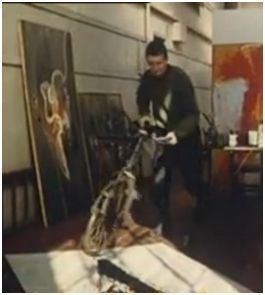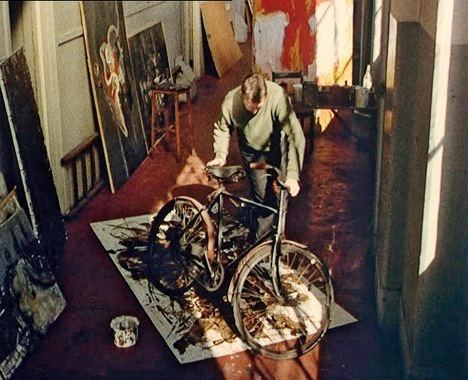Name William Green | Role Action painter | |
 | ||
William Green (1934–2001), was an artist who achieved fame in the late 1950s as a practitioner of Action painting. His work became controversial following a film of him creating paintings by riding a bicycle over a surface saturated with bitumen. From about 1965 Green withdrew from the art scene as a reaction to negative publicity. He resumed his work in 1995.
Contents

One of his works hangs in Tate Modern.
Early life
William Green was born in Greenwich, London, in 1934. After leaving school he worked in the drawing office of an architect in Sidcup, Kent. He then studied at Sidcup School of Art from 1952 to 1954, and there he made his first use of bitumen paint after discovering an old tin in his garden shed.
Green was accepted for the RCA in 1954, but as a conscientious objector to National Service, he was imprisoned from January 1955 for three months. At the RCA Green was in John Minton's tutorial group, and influenced by Expressionism.
Artistic career
Early in 1956 the exhibition "Modern Art in the United States" opened at the Tate Gallery, and included works by Abstract Expressionist artists, including Greene. He had already been strongly influenced by reproductions he had seen of works by Jackson Pollock and made a conscious decision to be a non-figurative painter. From then on he followed Pollock's example and worked on the floor, treating the paintings as his "arena" and using ever larger sheets of hardboard instead of canvas. Since late 1955 he had gradually eliminated colour from his paintings, and in spring 1956 he decided to only make black bitumen paintings, with their monochrome surfaces subjected to increasingly more brutal gestures and mark-making, including attack by fire.
In 1957 Green was approached by Lawrence Alloway and included in "New Trends in British Art" at the Rome-New York Art Foundation. Another of Green's paintings, Napoleon's Chest at Moscow was included in "Dimensions, British Abstract Art 1948-1957". During the winter of 1957/58 Green taught at a working men's college, making abstract etchings and experimenting with nitric acid on the metal plates as he was attracted by the possibilities of using acid to further traumatise the surface of his paintings. In 1958 Green was included in "Five Painters at the ICA", "Young Contemporaries No 9" and "Six Young Contemporaries".
In 1960 Green exhibited in the significant first "Situation" exhibition. He was then teaching at Luton with John Plumb, and they were invited by the Skoob Group of artists from Cambridge University to make a joint work in front of a large audience. Green was also invited by students at St Martin's School of Art to give a demonstration of his own brand of action painting. He produced a work in the central courtyard which he finally set on fire - the smoke rose to the top of the building while students watched from the windows on every floor.
Through his fellow student Tony Messenger, Green met the young photographer and film-maker Ken Russell. Russell made a series of photographs and the film that was to make Green notorious. Green was seen making action paintings by hurling bitumen and paraffin at a primed sheet of board before cycling across the picture, skidding over it in plimsolls and finally scorching the surface with fire. Green became infamous around the world, attracting a level of attention that made him among the most talked-about artists in Britain. His working methods were lampooned by Tony Hancock in his 1961 film The Rebel.
Later life
By 1965 Green had withdrawn completely from the art scene, to some extent as a result of negative publicly his work had attracted. His brief marriage had ended in the early 1960s and his son had been adopted by his ex-wife's new husband.
He returned to Sidcup in 1967 where he worked full-time at Havering Technical College until 1981 when he retired from teaching. When a student asked if he was the same William Green that he had read about in a book on Pop Art, he replied enigmatically "William Green is a very common name."
In 1995 Green started to paint again, taking up where he left off many years before. His first new works were made on paper, but he soon ordered large sheets of board and cans of bitumen and began to work outside the house, incorporating the effects of rain and fire on the surfaces of his black paintings. The results were shown at "The Susan Hayward Exhibition" at England & Co in London in 1993. Green was also featured in an exhibition at the Barbican in 1993, "The Sixties Art Scene in London", and in the book of the same title. The BBC made a documentary about Green for The Late Show that was shown around the same time.
He continued to paint every day and systematically sawed up and destroyed almost all his furniture and house contents, with the resulting debris incorporated in vast black bitumen-covered paintings. A group of these late works was exhibited in the Gardner Arts Centre at Sussex University in 1999, where he had been the subject of a previous exhibition, in 1964.
He died on 28 January 2001.
